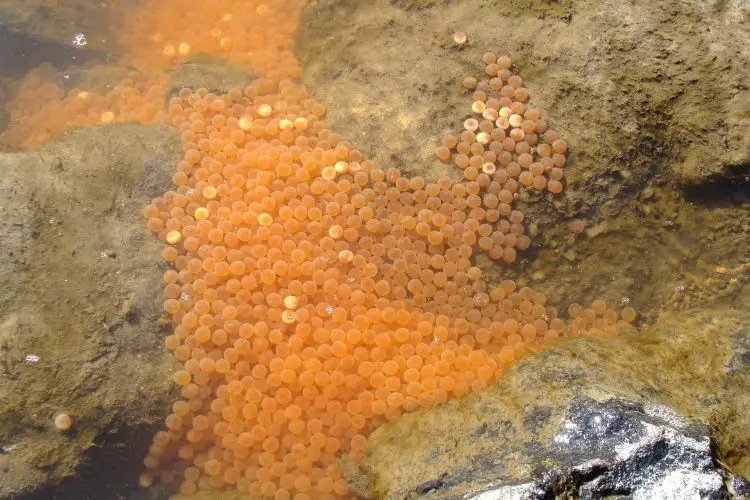Catfish are not livebearers which means that they lay their eggs during spawning. In fact, catfish can lay many eggs at once during the breeding season, preventing their population from depleting. The female lays the eggs and then the male fish deposits its sperm over the eggs.
What is spawning?
Spawning is when the female fish lays eggs and the male fish deposits sperm into the water. Spawning is usually a way of reproducing aquatic animals as most of them fertilize their eggs in this way. Moreover, the spawning of these aquatic animals most of the time occurs during a certain season. So, now you know what this term means and how important it is to keep the population of fish high in the wild.
Before spawning
Catfish are very interesting fish that are known for their whiskers which are actually called barbels that help them taste food without eating it and recognize the surroundings that they are in. They have barbels because the catfish live in a dark and muddy environment at the bottom of the river or pond in their natural habitat. Reproduction in catfish is just as interesting as the rest of their lives and anatomy.
There are some activities that catfish partake in before breeding. For a successful breeding session, the water conditions and the environment need to be suitable. Therefore, before breeding following are the factors that need to be met.
Maturity
Like humans, the fish needs to reach maturity to breed and produce fertile offspring. The time that the fish reaches maturity varies from species to species and also if they are in captivity or in the wild. The flathead catfish reaches maturity quite late, by the age of 10 years whereas, channel catfish reach maturity by the age of three in captivity and by the age five in the wild. When it comes to cory catfish, which are kept as a pet, it reaches maturity by one year or by the time it reaches the size of 2.5 inches.
Temperature
Another factor that determines the spawning session is the water temperature. Usually, catfish require warm waters to breed. You will find that most catfish breed once a year when the water reaches the temperature of 75 F to 80 F. This in the wild is during the summer; from March to June is their breeding time. In captivity, breeding also happens at the same time unless you bring the breeding tank to that temperature out of season.
Hormones
Catfish and all fish have hormones that control their maturity and reproduction as well. One such hormone is gonadotropins which increase while the fish is spawning and decrease after it is done. In fact, when female fish are present, this hormone increases in the male fish. This is connected to fish reaching maturity and is not the deciding factor in the reproduction of catfish.
During spawning
Now, let’s assume that the factors like temperature, maturity, hormones, light, and water current are all ideal for the breeding of catfish; what happens next? Well, they partake in reproduction, of course. Most of the female catfish breed only once a year with only one partner, although there can be slight variation among species. Regardless, here is what happens during reproduction.
Courting
Before the reproduction can start, the male catfish has to court the female catfish so that they can mate. Sometimes, the mates are made earlier, and then the mating occurs during the summer, almost like a couple. After the female fish has been courted, she will visit the nest built by the male fish where the eggs will grow. The nest is usually made on submerged timbers, weeds, and rocks to stay hidden from predators, and it is a flat surface covered in bubbles made by the male catfish or sometimes by both of them.
Reproduction
Then the male and female catfish will embrace each other for 20 seconds, around 10 to 18 times, and the spawning will take place inside the nest or near it. The female fish will lay more than 1000 eggs, and the amount is usually closer to 20,000 eggs. This doesn’t mean that all the eggs will survive, though; some will die. The older and bigger the fish, the more eggs the female lays.
The male fish release sperm at the same time and spray the eggs with the sperm. This is the last step after which fertilization is complete, and the eggs will be laid on the nest until they hatch.
After spawning
Once a successful fertilization has occurred the eggs need to be hidden and safe until the fry, which is small baby catfish, comes out. Sometimes the male fish chases away the female catfish to guard the eggs; even when this happens, the female fish still protects the eggs but from further away. However, sometimes both the parents protect the eggs. It can take anywhere from two days to 10 days for the eggs to hatch. After this, the parent fish still protect the fry that comes out of the eggs.
The male catfish and female fish both fight off all the predators that come near their babies and provide the necessary food until they think the fry can live on their own. Although there is no specific time when the parents stop caring for the fry, it usually takes a week. After this, the fry must take care of themselves and grow up to be mature and repeat the cycle of reproduction. The catfish grows a lot as juvenile fish, once they reach maturity, they still continue to grow but much slower.
In conclusion, spawning is a very interesting process in a catfish’s life. It is also possible to captivity breed these fish successfully, as they are kept in fish farms. Therefore, everyone should experience the breeding process of catfish in their lifetime, especially if they are fish lovers!











